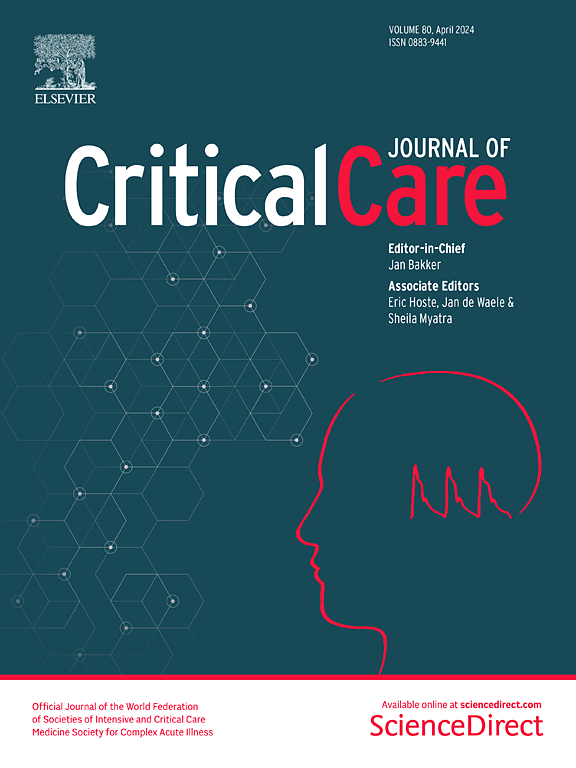医院获得性血流感染重症患者放弃维持生命治疗做法的差异:对 EUROBACT-2 国际队列的二次分析
IF 8.8
1区 医学
Q1 CRITICAL CARE MEDICINE
引用次数: 0
摘要
重症监护病房(ICU)中放弃维持生命治疗的决定受到伦理、文化和医疗因素的影响。本研究以医院获得性血流感染(HABSI)患者为研究对象,探讨患者、病原体、中心和国家级因素与这些决定之间的关联。我们分析了EUROBACT-2研究(2019年6月至2021年1月)中来自全球265个中心的数据,重点关注在医院内或HABSI后28天内死亡的非COVID-19患者。我们评估了患者死亡前是否决定放弃维持生命的治疗,并研究了国家、中心、患者和病原体等变量。为了评估每个潜在重要变量与放弃维持生命治疗的决定之间的关系,我们采用了具有随机中心效应的单变量混合逻辑回归模型。在1589名非COVID-19患者中,有519人(32.7%)死亡,其中191人(36.8%)决定放弃维持生命的治疗。与西欧、澳大利亚和亚洲相比,非洲国家没有关于放弃维持生命治疗的报告,中东地区的报告也较少。一旦考虑到中心效应,只有医疗支出(Odds ratio 1.79,95%CI:1.45-2.21,p < 0.01)和年龄(Odds ratio 1.02,95%CI:1.002-1.05,p = 0.03)与放弃维持生命治疗的决定显著相关,而其他患者和病原体因素则不相关。经济和地区差异极大地影响了重症监护病房的临终决策。全球政策应考虑这些差异,以确保临终关怀实践的公平性。本文章由计算机程序翻译,如有差异,请以英文原文为准。
Variability in forgoing life-sustaining treatment practices in critically Ill patients with hospital-acquired bloodstream infections: a secondary analysis of the EUROBACT-2 international cohort
The decision to forgo life-sustaining treatment in intensive care units (ICUs) is influenced by ethical, cultural, and medical factors. This study focuses on a population of patients with hospital-acquired bloodstream infections (HABSI) to investigate the association between patient, pathogen, center and country-level factors and these decisions. We analyzed data from the EUROBACT-2 study (June 2019–January 2021) from 265 centers worldwide, focusing on non-COVID-19 patients who died in the hospital or within 28 days after HABSI. We assessed whether death was preceded by a decision to forgo life-sustaining treatment, examining country, center, patient, and pathogen variables. To assess the association of each potentially important variable with the decision to forgo life-sustaining treatment, univariable mixed logistic regression models with a random center effect were performed. Among 1589 non-COVID-19 patients, 519 (32.7%) died, with 191 (36.8%) following a decision to forgo life-sustaining treatment. Significant geographical differences were observed, with no reported decisions to forgo life-sustaining treatment in African countries and fewer in the Middle East compared to Western Europe, Australia, and Asia. Once a center effect was considered, only health expenditure (Odds ratio 1.79, 95%CI: 1.45–2.21, p < 0.01) and age (Odds ratio 1.02, 95%CI: 1.002–1.05, p = 0.03) were significantly associated with decisions to forgo life-sustaining treatment, while other patient and pathogen factors were not. Economic and regional disparities significantly impact end-of-life decision-making in ICUs. Global policies should consider these disparities to ensure equitable end-of-life care practices.
求助全文
通过发布文献求助,成功后即可免费获取论文全文。
去求助
来源期刊

Critical Care
医学-危重病医学
CiteScore
20.60
自引率
3.30%
发文量
348
审稿时长
1.5 months
期刊介绍:
Critical Care is an esteemed international medical journal that undergoes a rigorous peer-review process to maintain its high quality standards. Its primary objective is to enhance the healthcare services offered to critically ill patients. To achieve this, the journal focuses on gathering, exchanging, disseminating, and endorsing evidence-based information that is highly relevant to intensivists. By doing so, Critical Care seeks to provide a thorough and inclusive examination of the intensive care field.
 求助内容:
求助内容: 应助结果提醒方式:
应助结果提醒方式:


